SCERT AP 7th Class Social Study Material Pdf 2nd Lesson Forests Textbook Questions and Answers.
AP State Syllabus 7th Class Social 2nd Lesson Questions and Answers Forests
7th Class Social 2nd Lesson Forests Textbook Questions and Answers
Observe the given picture.
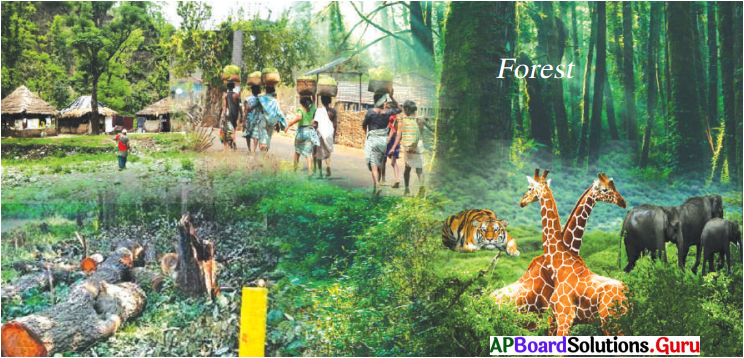
Answer the following questions.
Question 1.
Look at the above figure and say what do you observe in the figure?
Answer:
Forest, Birds and Wild animals habitation.
Question 2.
What are the components you can see in the forest ? Complete the given diagram.
Answer:
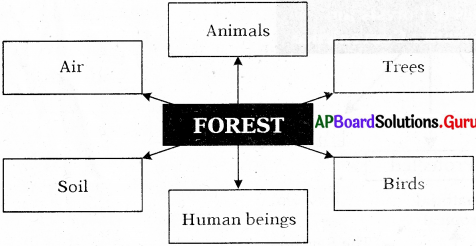
Question 3.
Express your views about the forest in your own words.
Answer:
In my words, a forest is a piece of land with many trees. Many animals need forests to live and survive.
Forests are very important and grow in many places around the world. They are an ecosystem which includes many plants and animals.
We depend on forests for our survival.
Improve Your Learning
I. Answer the following questions.
1. A) Mention the types of forests in India.
Answer:
For -administrative convenience, the Government of India divided forests into three types. They are :
- Reserved forests
- Protected forests
- Unclassified forests.
B) Into how many types forests are classified?
Answer:
Forests are divided into five types based on climate, rainfall and types of soils. They are :
- Evergreen forests
- Deciduous forests
- Thorny forests
- Mangrove forests
- Montane forests
![]()
Question 2.
Describe briefly about the Evergreen forests.
Answer:
Evergreen Forests :
- Evergreen forests are grown in the areas with high rainfall more than 200 cm.
- Trees in this area are very tall and they contain broad leaves.
- The trees in these forests remain green throughout the year. _
- These forests are located in Himalayan region, North-eastern states and Western ghats.
- Mahogany, Ebony, Rosewood trees etc. are found.
- Different types of snakes, Lion-tailed macaque and a variety of insects found here.
Question 3.
Describe the features of deciduous forests. Explain about flora and fauna of these forests in India.
Answer:
- The deciduous forest are grown in areas with rainfall between 70 cm and 200 cm.
- These forests are located in Peninsular plateau.
- The trees shed their leaves during very dry months to minimise transpiration.
Flora of this region :
Teak, Sal, Bamboo, Rosewood, Sandalwood, Neem, Shisham, Khair, Kusum, Arjun and Mulberry trees are found.
Fauna of this region :
The most common animals are found in this region like, Deers, Hares, Elephants, Tigers, Leopards, Peacocks, several species of Birds, etc.
Question 4.
Explain in detail about the thorn forests in India?
Answer:
- The thorn forests are found in regions with less than 70 cm of rainfall.
- Due to the arid climate most of the trees in these forests are sharp, thorny and bushy.
- This type of vegetation is found in the north-western parts of the country.
- Trees are scattered and have long roots penetrating deep into the soil in order to get moisture.
- The stems are succulent to conserve water.
- These forests are found in Madhya Pradesh, Uttar Pradesh, Rajasthan and Haryana.
Question 5.
Prepare some slogans on “conservation of forests”.
Answer:
- Save forests – Save the climate and wild life.
- Plant a tree – Keeps the flood away.
- Don’t destroy the greenery and don’t spoil the scenery. Save mother earth.
- Trees are Green Gold.
- Save trees now – They will save you in future.
- Plant a tree – Predict the mother earth.
![]()
Question 6.
“Forests are essential for us, but yve destroy them.” Respond on this.
Answer:
The uses of forests.
- Forests play a major role in our life.
- Forests prevent soil erosion and floods.
- Trees help to regulate the climate of a place.
- We get more products which are needed to us from forests.
Even though the forests are useful for us, but we destroy them due to following relfeons.
- The ever-growing human consumption and population is the biggest cause of forest destruction.
- Along with population increase we need resources, products and services, so we destroy the forest.
- For the development of our nation for mining, for infrastructure projects, for agriculture purpose there is no other alternative so we destroy the forests.
Conclusion :
Governments will invent alternative resources for the development of our nation without destroying the forests.
Question 7.
List out the resources of the forests used by you in your daily life.
Answer:
The following resources are used by ourselves in our daily life from the forests.
- Notebooks → Wood pulp is used
- Furniture → Wood is used
- Medicines → Herbs are used
- Food & Fodder → Roots, tubers, bean sprouts, etc.
- Beedi leaves → Making beedis
- Bamboo is used for making fences
- Essential oils → Eucalyptus tree, camphor
- Fruits → Coconut, pear
- Cane → Walking sticks, etc.
Question 8.
Read about policies of forests and Fill in the following table.
| Year | Name of the policy | Objectives |
| 1894 | ||
| 1950 | ||
| 1952 | ||
| 1980 | ||
| 1988 |
Answer:
| Year | Name of the policy | Objectives |
| 1894 | The Forest Law | Meeting needs of local people and after meeting local needs maximum revenue collection. |
| 1950 | Forest Festival | Vana Mahotsav – Create awareness on about saving forests, and bad effects of deforestation. |
| 1952 | National Forest Policy | Should maintain 33% of forest cover. |
| 1980 | Forest Conservation Act | 1) To protect the forest, its flora, fauna and other diverse ecological component.
2) To protect the integrity, territory, and individuality of the forests., |
| 1988 | National Forest Policy | Taking steps to create massive people’s movement with involvement of women to achieve the objectives and minimise pressure on existing forest. |
II. Choose the correct answer.
1. Which forests are green throughout the year?
a) Deciduous forests
b) Evergreen forests
c) Tidal forests
d) Mangrove forests
Answer:
b) Evergreen forests
2. Which of the following is not the slogan of conservation of forests?
a) Save the trees save the earth.
b) Save nature save future.
c) Greenery for better environment.
d) Good food good life.
Answer:
d) Good food good life.
3. Which of the following one is not a forest product?
a) Timber
b) Honey
c) Plums
d) Bread
Answer:
d) Bread
4. In which year was the National Conservation Policy enacted by the Central government?
a) 1984
b) 1950
c) 1952
d) 1980
Answer:
d) 1980
5. Which of the following forests have a variety of snakes and insects?
a) Evergreen forests
b) Deciduous forests
c) Mangrove forests
d) Thorny forests
Answer:
a) Evergreen forests
III. Match the following.
1.
| Group-A | Group-B |
| 1. Evergreen forests | A) Snow Leopard. |
| 2. Deciduous forests | B) Variety of fishes. |
| 3. Montane forests | C) Lion tailed macaque. |
| 4. Mangrove forests | D) Different kinds of deers. |
Answer:
| Group-A | Group-B |
| 1. Evergreen forests | C) Lion tailed macaque. |
| 2. Deciduous forests | D) Different kinds of deers. |
| 3. Montane forests | A) Snow Leopard. |
| 4. Mangrove forests | B) Variety of fishes. |
2.
| Group-A | Group-B |
| 1. High rainfall | A) Mangrove forest. |
| 2. Little rainfall | B) Montane forests. |
| 3. Coastal line | C) Evergreen forests. |
| 4. Mountain region | D) Thorny forests |
Answer:
| Group-A | Group-B |
| 1. High rainfall | C) Evergreen forests. |
| 2. Little rainfall | D) Thorny forests |
| 3. Coastal line | A) Mangrove forest. |
| 4. Mountain region | B) Montane forests. |
Puzzle
Solve the puzzle with the words related to given hints.
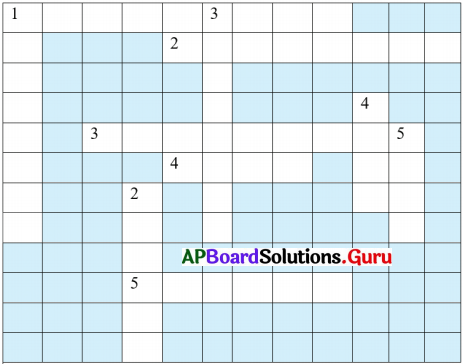
Cross:
1. Largest hills in Andhra Pradesh (9).
2. Flora in evergreen forests (8).
3. These are known as Selvas (9).
4. Product of forest (4).
5. Raw material for Paper (6).
Down :
1. Hills in Tamilnadu (7).
2. Product of forest (6).
3. Forest in coastal region (8).
4. Product of forest (4).
5. Flora in deciduous forest (4).
Answer:

7th Class Social 2nd Lesson Forests InText Questions and Answers
7th Class Social Textbook Page No. 20
Question 1.
Locate a few important countries in various climatic regions in the world map.
Answer:
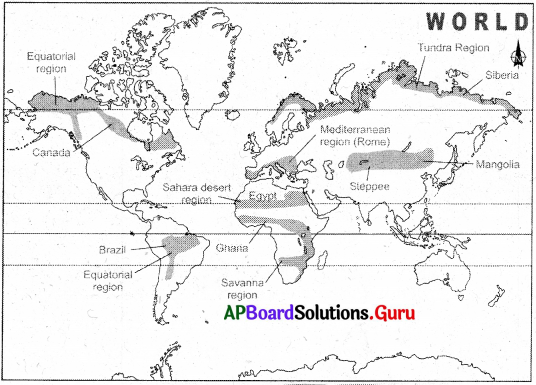
Question 2.
Prepare a table with various climatic regions and important countries in those regions.
Answer:
| Climatic regions | Countries |
| Equatorial / Tropical Climatic Region |
South America – Brazil Asia – Indonesia Africa – Kenya, etc. |
| The Savanna | India-China Australia ‘ |
| Desert region | Sahara – Egypt, Libya Kalahari – Namibia Australian Desert – Australia Thar desert – India |
| Mediterranean Climate | Europe – Spain, Italy, Turkey, Israel, Greece, etc. |
| Steppe Climate | Ukraine, China, Uzbekistan, etc. |
| Taiga Region | Alaska, Canada, Scandinavia, etc. |
| Tundra Region | Russia, Greenland, Iceland – Sub – Antarctic islands |
7th Class Social Textbook Page No. 21
Question 3.
Locate the Ever-green forests in an outline map of India.
Answer:
7th Class Social Textbook Page No. 22
Question 4.
Locate the areas of Deciduous forests in an outline map of India.
Answer:
![]()
Question 5.
Locate the areas of Thorny and shrub forests in an outline map of India.
Answer:
7th Class Social Textbook Page No. 23
Question 6.
Locate the areas of Montane forests in an outline map of India.
Answer:
Question 7.
Fill up the following table.
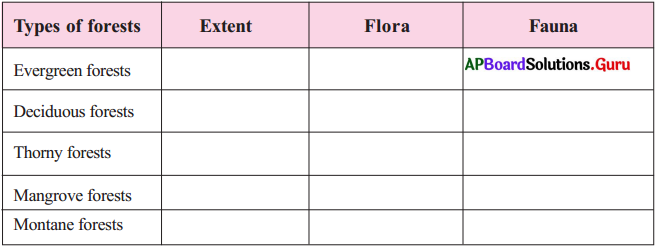
Answer:
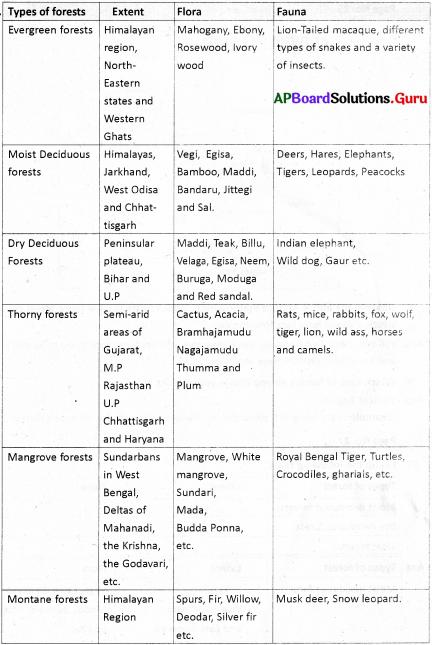
7th Class Social Textbook Page No. 25

Question 8.
Observe the above Andhra Pradesh map. Which districts have more forest cover and which districts have less forest cover.
Answer:
YSR Kadapada, East Godavari, Visakhapatnam districts have more forest cover and Krishna and Anantapur districts have less forest cover.
![]()
Question 9.
Witch type of forests do you find in your district?
Answer:
(Example : I am living in Krishna district. Mangrove forests are in Krishna district.)
7th Class Social Textbook Page No. 27
Question 10.
Fill up the following table.
| Types of forest | Extent | Flora |
| Moist deciduous forests | ||
| Dry deciduous forests | ||
| Tidal forests |
Answer:
| Types of forest | Extent | Flora |
| Moist deciduous forests | Srikakulam, Visakhapatnam and East Godavari | Vegi, Egisa, Bamboo, Maddi, Bandaru, Jittegi and Sal. |
| Dry deciduous forests | YSR Kadapa, Kurnooi, Ananthapur, and Chittoor. | Maddi, Teak, Biliu, Velaga, Egisa, Neem, Buruga, Moduga and Red sandal. |
| Tidal forests | Korangi region of East Godavari | Uppu ponna, Boddu ponna, Urada, Mada, Tellamad-a, Patri Teega and Balabandi Teega. |
7th Class Social Textbook Page No. 29
Question 11.
Prepare some slogans on social forestry.
Answer:
Slogans :
- A tree that stay, keep flood away
- Don’t cut a tree don’t cut a life.
- Don’t cut trees if you want cool air. ‘
- No Trees, No Mankind.
- Plant a tree today; make the life of the earth much longer.
Question 12.
Plant a tree on your birthday and take care of it.
Answer:
Question 13.
Gift a plant on important occasions to your friends and relatives.
Answer:
7th Class Social Textbook Page No. 30
Question 14.
Make a poster on tribal culture and tribal products.
Answer:

Question 15.
Celebrate Vana Mahostav in your school/locality and plant a few plants and notice their growth.
Answer:
Think & Respond
7th Class Social Textbook Page No. 20
Question 1.
Compare the climate of the various climatic regions.
Answer:
| Climatic regions | Comparision of climatic condition |
| Tropical climatic region | High temperature and heavy precipitation |
| The Savanna | The climate is usually warm and temperature ranges from 20° to 30°C. Annual rainfall – 25 to 75 cm per year. |
| Desert Region | Hot summers and cold winters, high diurnal range of temperatures. |
| Mediterranean Climate | Pleasant climate with dry summer, and moderate to high rainfall in winter. |
| Steppe climate | Extremes of heat & cold low amount of rajnfall. |
| Taiga climate | Winters are extremely cold and long whereas summers are moderately hot and short. |
| Tundra climate | The climate is cold and windy and rainfall is scanty. |
If we compare the different regions through above table, equatorial region has high temperature & high rainfall compare with Taiga and Tundra regions. Desert regions have high temperature. Compare with mediterranean climate. Steppes have low amount of rainfall.
![]()
Question 2.
What is the impact of climate on natural vegetation in climatic regions ?
Answer:
- The amount of temperature, rainfall, moist in air and soil determine the type of vegetation in forest.
- Ex : Evergreen forests in high temperature and rainfall regions – Bushy plants in arid regions.
Question 3.
Name the plants in forest which are having medicinal values.
Answer:
The commonly used plants in India are :
1) Sarpagandha :
Used to treat blood pressure, it is found only in India.
2) Jamun :
The powder of the seed is used for controlling diabetes.
3) Arjun
: The fresh juice of leaves is cure for ear ache.
4) Babool :
Leaves are used as a cure for eye sores.
5) Neem :
Has high antibiotic and antibacterial properties.
6) Tulasi plant :
Is used to cure cough and cold.
7) Kachnar :
Is used to cure asthma and ulcers.
7th Class Social Textbook Page No. 21
Question 4.
Why is a variety of flora and fauna found in evergreen forests ?
Answer:
- Evergreen forests are located in tropical regions.
- They receive a lot of sunlight and rainfall.
- There is a lot of energy in these forests.
- This energy is stored in plant vegetation, which is eaten by animals.
- The thick, dense forests are abode of Herbivorous and Carnivorous animals. So, a variety of flora and fauna is found in evergreen forests.
7th Class Social Textbook Page No. 22
Question 5.
Trees in deciduous forests shed their leaves. When and why ?
Answer:
The trees in deciduous forests shed their leaves during very dry months to minimise transpiration.
Question 6.
Have you ever seen the beauty of deciduous forests ? Describe the beauty of the forest.
Answer:
Yes. I have seen the beauty of deciduous forests.
- Forests are the nature gift to human beings. The deciduous forests shed leaves during the months of February and March.
- This is to reduce the consumption of water that it releases through leaves in the form of transpiration
- At that time the trees in the forest look completely dry.
- But when it starts budding of new leaves in spring, the forest looks very shiny and fresh. Later all the trees turned into very beautiful scenic view with shiny leaves and blossoms.
- One should watch and admire the picturesque marvel of deciduous forests.
![]()
Question 7.
Mangrove forests are natural protectors of sea coast. Discuss.
Answer:
Mangrove swamps protect coastal areas from erosion, storm surge and tsunamis.
Mangroves act as shock absorbers. They reduce high tides and waves and help prevent soil erosion.
The mangroves massive root systems are efficient at dissipating wave energy.
7th Class Social Textbook Page No. 24

Question 8.
Observe the above map. Which state has more forest cover. Give reasons.
Answer:
Madhya Pradesh state in India has more forest area.
The following reasons are responsible for more forest area in Madhya Pradesh.
Madhya pradesh has two horizontal mountain ranges from East to West. Vindya and Satpur mountains. These two ranges make a buffer of heavy clouds coming from South.
Hence, it results in longer period of rains and creates many seasonal rivers and ponds, which help dense forests.
Question 9.
Which state has less forest cover. Give reasons.
Answer:
- Punjab has the lowest forest cover with respect to total geographical area in India at 6.79 percent. It is a small state. Most of the people depended on agriculture only. As most of the land is under the cultivation there is less forest cover.
- Gujarath and Rajasthan states have less forest cover due to adverse conditions in most of their area.
Question 10.
The Western side of the Western Ghats is covered with thick forest than the Eastern side. Find the reason.
Answer:
Western Ghats are layered with thick evergreen forests because they receive more rainfall as compared to the Eastern Ghats that are covered with deciduous forests.
The Western Ghats get their rainfall from the monsoon winds that blow from Arabian sea.
7th Class Social Textbook Page No. 26
Question 11.
What are the uses of Red Sandalwood and Sandalwood?
Answer:
Uses of Red Sandalwood.
- Red Sandalwood is a tree.
- The wood at the centre of the trunk is used as medicine.
- Red Sandalwood is used for treating digestive tract problems, fluid retention, coughs, and for blood purification.
- In manufacturing, red Sandalwood is used as a flavoring in alcoholic beverages.
Uses of Sandalwood :
- Sandalwood is used as a fragrance in incense, cosmetics, perfumes and soaps.
- It is also used as a flavour for foods and beverages.
- The wood has been valued in carving because of its dense character.
- It is also used for medicinal purpose for headache, stomachache and urinary and genital disorders.
7th Class Social Textbook Page No. 27
Question 12.
Why do tribal people reject to leave the forests?
Answer:
- The tribal people lived in forest area for generations.
- They cleared the forests and follow agriculture.
- They worshipped nature gods.
- They domesticated animals.
- Their entire life depends on forests. ,
So they reject to leave the forests.
7th Class Social Textbook Page No. 28
Question 13.
What is the role of forests in conservation of environment?
Answer:
Role of forests in conservation of environment : „
- Prevent soilerosion and help in maintaining fertility of soil.
- They provide shelter to wild animals and are areas that sustain biodiversity.
- They reduce atmospheric pollution.
- They increase humidity and frequency of rainfall.
- They check the increase of atmospheric temperature.
![]()
Question 14.
Write a list of items made from forest products in your surroundings.
Answer:
The following items we are using in our daily life.
Foods : Honey, Fruits, Palm oil, Mushroom, etc.
Wood : Furniture, paper, decorative items, etc.’
Medicines : Natural Aspirin and Acne medication.
Other items : Chewing Gum, Sponges, Carnauba wax, Henna Dye, Rubber, etc.
7th Class Social Textbook PageNo.29
Question 15.
What are the reasons for deforestation?
Answer:
- Agriculture
- Urbanization
- Industrialization
- Forest fires
- Mining
- Construction of Dams and Reservoirs etc. are the reasons for deforestation.
Question 16.
What are the consequences of deforestation?
Answer:
- Flooding
- Loss of soil
- Loss of biodiversity
- Climatic change
- Health problems and
- Displacement of the indigenous people are the consequences of deforestation.
- Imbalance of ecosystem causing natural calamities.
- Loss of habitat of wild life.
Question 17.
Suggest a few measures for afforestation!
Answer:
Methods that can be used to enhance afforestation are :
- Increase the number of planting trees and protect them.
- Choose the barron lands, waste lands to plant trees under social forestry.
- Road side areas, industrial areas can be enriched with thick growth of trees.
- Encourage the plants that provide forest products to the needy so that they pay interest to conserve them.
Question 18.
Do you observe any plantation of trees in your surroundings? What are the uses of plantation?
Answer:
Yes. I observed.
Uses of plantation :
- The more trees are there, the cleaner the air will be.
- Trees and forests can provide natural filtration, resulting in cleaner wafer.
- Planting trees can help to slow down the process of heat trapping of carbondioxide in our atmosphere.
- Trees are essentially nature’s wind-breakers, providing protection and shade during hot weather and dazzling sunshine.
Explore
7th Class Social Textbook Page No. 20
Question 1.
Go through library books or internet to know more about climatic regions.
Answer:
![]()
Question 2.
Know about Podu cultivation with the help of your teacher.
Answer:
Podu is a traditional system of cultivation used by tribes in India, whereby different areas of jungle forest are cleared by burning each year to provide land for crops.
Podu is a form of shifting agriculture using slash-and-burn methods. Traditionally used on the hill-slopes of Andhra Pradesh. It is also known as Jhum cultivation.
7th Class Social Textbook Page No. 29
Question 2.
Go throiigh library books or browse internet to know more information about the given forest acts.
Answer:
The objectives of Forests Acts :
- To consolidate all the previous laws regarding forests.
- To give the Government the power td create different classes of forests for their effective usage for the colonial purpose.
- To regulate movement and transit of forest produce, and duty leviable on timber and other forest produce.
- To define the procedure to be followed for declaring an area as Reserved Forest, Protected Forest or Village Forest.
- To define forest offences acts prohibited inside the Reserved Forest, and penalties leviable on the violation.
- To make conservation of forests and wildlife more accountable.
Project Work
Prepare a model of forest use with natural material. Ans. Student’s own activity.